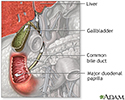Cholangiocarcinoma
Bile duct cancer
Cholangiocarcinoma (CCA) is a rare cancerous (malignant) growth in one of the ducts that carries bile from the liver to the small intestine.
Causes
The exact cause of CCA isn't known. However, many of these tumors are already quite advanced by the time they are found.
CCA may start anywhere along the bile ducts. These tumors block off the bile ducts.
Both men and women are affected. Most people are older than 65.
People with the following health problems may have a higher chance of developing CCA:
- Bile duct (choledochal) cysts
- Chronic biliary and liver inflammation
- History of infection with parasitic worms, liver flukes
- Primary sclerosing cholangitis
- Ulcerative colitis
Symptoms
Symptoms of CCA may include any of the following:
- Fever and chills
- Clay-colored stools and dark urine
- Itching
- Loss of appetite
- Pain in the upper right abdomen that may radiate to the back
- Weight loss
- Yellowing of the skin (jaundice)
Exams and Tests
Your health care provider will perform a physical exam. Tests will be done to check for a tumor or blockage in the bile duct. These may include:
- Abdominal CT scan
- Abdominal ultrasound
- Procedure that uses a viewing scope to look at the bile ducts (ERCP), during which tissue may be taken and looked at under a microscope
Blood tests that may be done include:
- Liver function tests (especially alkaline phosphatase or bilirubin levels)
- Complete blood count (CBC)
Treatment
The goal is to treat the cancer and the blockage it causes. When possible, surgery to remove the tumor is the treatment of choice and may result in a cure. Often the cancer has already spread locally or to another area of the body by the time it is diagnosed. As a result, surgery to cure the cancer is not possible.
Chemotherapy or radiation may be given after surgery to decrease the risk of the cancer returning.
In select cases, a liver transplant can be tried.
Endoscopic therapy with stent placement can temporarily relieve blockages in the biliary ducts. This may also relieve jaundice when the tumor cannot be removed.
Outlook (Prognosis)
Completely removing the tumor allows some people to survive with the possibility of complete cure.
The survival time varies greatly from several months to several years. Outlook depends on:
- The location of CCA
- The cell type of CCA
- The stage of the tumor
- The person's age and general health
- Whether surgery is an option
- The person's response to treatment
If the tumor cannot be completely removed, a cure is generally not possible. With treatment, about one half of affected people live a year, and about one half live longer, but rarely beyond 5 years. You and your family may want to start thinking about end-of-life planning, such as:
- Palliative care
- Hospice care
- Advance care directives
- Health care agents
Possible Complications
Complications of CCA include:
- Infection
- Liver failure
- Spread (metastasis) of tumor to other organs
When to Contact a Medical Professional
Call your provider if you have jaundice or other symptoms of cholangiocarcinoma.
References
Gibson RN, Sutherland TR. The biliary system. In: Adam A, Dixon AK, Gillard JH, Schaefer-Prokop CM, eds. Grainger & Allison's Diagnostic Radiology. 7th ed. Philadelphia, PA: Elsevier; 2021:chap 24.
National Cancer Institute website. Bile duct cancer (cholangiocarcinoma) treatment (PDQ) -- health professional version. www.cancer.gov/types/liver/hp/bile-duct-treatment-pdq. Updated June 2, 2022. Accessed June 24, 2022.
Rajkomar K, Koea JB. Intrahepatic cholangiocarcinoma. In: Jarnagin WR, ed. Blumgart's Surgery of the Liver, Biliary Tract and Pancreas. 6th ed. Philadelphia, PA: Elsevier; 2017:chap 50.
Rizvi SH, Gores GJ. Tumors of the bile ducts, gallbladder, and ampulla. In: Feldman M, Friedman LS, Brandt LJ, eds. Sleisenger and Fordtran's Gastrointestinal and Liver Disease. 11th ed. Philadelphia, PA: Elsevier; 2021:chap 69.
Review Date: 4/29/2022
Reviewed By: Todd Gersten, MD, Hematology/Oncology, Florida Cancer Specialists & Research Institute, Wellington, FL. Review provided by VeriMed Healthcare Network. Also reviewed by David C. Dugdale, MD, Medical Director, Brenda Conaway, Editorial Director, and the A.D.A.M. Editorial team.
















